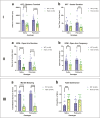Premorbid characteristics of the SAPAP3 mouse model of obsessive-compulsive disorder: behavior, neuroplasticity, and psilocybin treatment
- PMID: 40156912
- PMCID: PMC12062877
- DOI: 10.1093/ijnp/pyaf022
Premorbid characteristics of the SAPAP3 mouse model of obsessive-compulsive disorder: behavior, neuroplasticity, and psilocybin treatment
Abstract
Background: SAPAP3-knockout (SAPAP3-KO) mice develop excessive self-grooming behavior at 4-6 months of age, serving as a model for obsessive-compulsive disorder (OCD). Given that anxiety often precedes OCD diagnosis in humans, this study investigated whether juvenile SAPAP3-KO mice exhibit anxiety-like behaviors before developing the self-grooming phenotype, and whether such behaviors respond to psilocybin (PSIL) treatment. The study also examined 4 key neuroplasticity-related synaptic proteins-GAP43, PSD95, synaptophysin, and SV2A-as SAPAP3 is a postsynaptic scaffold protein that interacts with PSD95 and may affect synaptic function.
Methods: Two studies were conducted using male and female juvenile (10-13 weeks) SAPAP3-KO mice. Study 1 compared behavioral phenotypes between homozygous (HOM), heterozygous, and wild-type (WT) mice. Study 2 evaluated a different sample of HOM and WT mice and assessed the effect of PSIL (4.4 mg/kg) on identified behavioral differences. Both studies included comprehensive behavioral testing focused on anxiety-like behavior, social interaction, and cognitive function. Additionally, levels of 4 synaptic proteins were measured by western blots in the frontal cortex, hippocampus, amygdala, and striatum of juvenile and adult SAPAP3-KO mice.
Results: In both studies, juvenile HOM SAPAP3-KO mice showed significant anxiety-like behaviors compared to WT mice, spending less time in open field center, and elevated plus maze open arms. They also buried fewer marbles and found fewer buried Oreos than WT mice. Psilocybin treatment did not improve these behavioral manifestations. Analysis of synaptic proteins revealed significant increases in GAP43, synaptophysin, and SV2A across multiple brain regions in adult male HOM mice and of SV2A in the frontal cortex of HOM females compared to WT, but not in juvenile mice of either sex.
Conclusions: Juvenile SAPAP3-KO mice exhibit anxiety-like behaviors before developing the characteristic excessive self-grooming phenotype, paralleling the prodromal anxiety often seen in human OCD. Unlike in adult SAPAP3-KO mice, these manifestations were not responsive to PSIL treatment. The age-dependent increases in synaptic proteins observed in adult (but not juvenile) male SAPAP3-KO mice HOM for the deletion and to a lesser extent in female homozygotes, may represent compensatory plasticity changes in response to the phenotype. These results provide insights into the developmental trajectory of OCD-like behaviors and associated neuroplastic adaptations.
Keywords: SAPAP3; Tourette’s syndrome; head-body twitches; obsessive-compulsive disorder; self-grooming.
© The Author(s) 2025. Published by Oxford University Press on behalf of CINP.
Conflict of interest statement
B.L. is a consultant to Back of the Yards Algae Sciences (BYAS) and Parow Entheobiosciences (Parow Entheobiosciences ParowBio). ParowBio has submitted a patent application (WO 2023\164092 A1) on the use of psilocybin-containing psychedelic mushroom extract to treat psychiatric disorders including OCD on which B.L. is a co-inventor. None of the other authors have any conflict of interest.
Figures






References
-
- Welch JM, Lu J, Rodriguiz RM, et al.Cortico-striatal synaptic defects and OCD-like behaviours in Sapap3-mutant mice. Nature. 2007; 448:894–900. https://doi.org/10.1038/nature06104 - DOI - PMC - PubMed
-
- Lamothe H, Schreiweis C, Mondragón-González LS, et al.The Sapap3−/− mouse reconsidered as a comorbid model expressing a spectrum of pathological repetitive behaviours. Transl Psychiatry. 2023; 13:26. https://doi.org/10.1038/s41398-023-02323-7 - DOI - PMC - PubMed
-
- Brownstien M, Lazar M, Botvinnik A, et al.Striking long term beneficial effects of single dose psilocybin and psychedelic mushroom extract in the SAPAP3 rodent model of OCD-like excessive self-grooming. Molecular Psychiatry 2025; 30:1172–1183. https://doi.org/10.1038/s41380-024-02786-0 - DOI - PMC - PubMed
-
- Willner P. Validation criteria for animal models of human mental disorders: learned helplessness as a paradigm case. Prog Neuropsychopharmacol Biol Psychiatry. 1986; 10:677–690. https://doi.org/10.1016/0278-5846(86)90051-5 - DOI - PubMed
-
- Davis GL, Minerva AR, Lario A, et al.Ketamine increases activity of a fronto-striatal projection that regulates compulsive behavior in SAPAP3 knockout mice. Nat Commun. 2021; 12:6040. https://doi.org/10.1038/s41467-021-26247-2 - DOI - PMC - PubMed
Publication types
MeSH terms
Substances
Grants and funding
LinkOut - more resources
Full Text Sources
Medical
Research Materials

